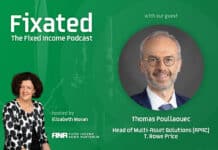
By Robert Tipp, CFA, Chief Investment Strategist & Head of Global Bonds at PGIM Fixed Income
This year has been a roller-coaster for the bond market as alternating waves of pessimism and optimism mirrored the wide swings in economic data. However, higher yielding sectors, such as high yield corporates and hard currency emerging markets debt, continued to post positive returns.
An environment of high and stable long-term rates supports the bull case for fixed income. For those seeking a quick drop in yields, this will be a disappointing market. Even with the likelihood of rate cuts, long-term yields should remain centred around current levels as:
- A fair amount of rate cuts are already priced in
- Loose fiscal policy—and its resulting heavy government bond issuance—may impede any substantial, sustained decline in long rates.
On net, this will likely result in a slow normalisation of the yield curve with the outcome being little change in the range for long rates, despite any drop in short rates.
The Appeal for Bonds is in its Strategic Value
Granted, a range bound rate backdrop may seem like an uninteresting opening volley for a “bullish thesis for bonds.” But this stability provides context to a few strategic points as events unfold in the second half of the year and beyond.
First, the value of bonds from an asset allocation perspective is not to be underestimated given the shifts in valuations and the current point in the economic cycle.
Second, the defensive characteristics of bonds at this point in the cycle are striking. If stocks experience a sharp correction while the Fed is on hold or cutting rates, bonds historically perform as solid shock absorbers in investors’ portfolios.
Lastly, the long-term outlook for positive excess returns from credit—albeit at a less fevered pitch given the level of spreads— remains favorable thanks to positive fundamentals, issuer restraint, and a benign technical backdrop as investors move into fixed income to lock in higher returns at the peak of the interest-rate cycle.
Also read: PGIM – Credit Risks and Deteriorating Lending Standards
Short Term Volatility Still Expected
Nevertheless, the short term is a much tougher call. Although we expect relatively stable rates over the long term, the northern summer is notorious for lower liquidity and outsized reactions to shocks, of which any number are possible: Eurozone or U.S. debt concerns and/or rising geopolitical risks in the Mideast, South China Sea, or even in the Western hemisphere as Russia increases its military presence.
We continue to see opportunities to add value in a volatile market. From an asset allocation perspective, the case for bonds is solid given their current relative valuations. Longer term, the outlook for fixed income as an asset class looks strong on an absolute and relative basis with ample opportunities to add value through sector rotation and issue selection in volatile markets.
Impact of Loose Fiscal Policy and Rising Government Indebtedness
Periodically, but with increasing frequency, investors’ attention turns to loose fiscal policy and rising levels of indebtedness.
When investors are optimistic about disinflation and rate cuts, they don’t seem to worry about debt burdens, deficits, and government bond issuance. But the fact of the matter is that debt burdens for countries like the U.S. and France are adding up as bouts of stimulus for crises, such as the GFC and COVID, get piled on top of what are already perennially high deficits.
In other words, the 90%+ highly indebted zone has gone from a rarity among DM countries to more of a norm. The impact of these higher debt burdens is twofold. One, it leaves markets vulnerable to bouts of volatility. Second, is the fact that higher debt burdens lead to a chronic increase in the average, long-term cost of a government’s debt service.
Over the last few decades, US Treasury yields have risen relative to swaps along with the increase in the government’s level of indebtedness. As the government swung from a situation of surplus and paying down the debt to one of yawning deficits and a strikingly high debt-to-GDP ratio, the Treasury’s cost of issuance has risen by roughly 2% relative to a supply neutral benchmark.
Our takeaway is that government indebtedness is increasingly becoming a market driver in the post-COVID environment. Government yields versus swaps will continue to be profoundly impacted by debt trajectories, creating both risks and opportunities for credit investors.

































